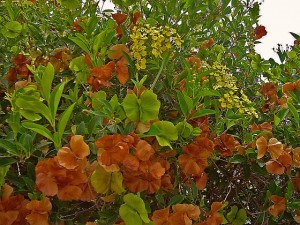July 24, 2006
 The clusters of dainty flowers on Butterfly Vine shine as brilliant as the summer sun. But it’s the seed pods that give the plant its name. During summer, chartreuse ‘wings’ unfold on the seed pods that look like butterflies. The papery pods will turn tan to brown as they mature, and they can be harvested and planted. In mild winters, the vine will retain its gloss green foliage. It will die back and resprout in spring after a cold winter. The plant recently was renamed; it previously was classified as Stigmaphyllon ciliatum.
The clusters of dainty flowers on Butterfly Vine shine as brilliant as the summer sun. But it’s the seed pods that give the plant its name. During summer, chartreuse ‘wings’ unfold on the seed pods that look like butterflies. The papery pods will turn tan to brown as they mature, and they can be harvested and planted. In mild winters, the vine will retain its gloss green foliage. It will die back and resprout in spring after a cold winter. The plant recently was renamed; it previously was classified as Stigmaphyllon ciliatum.
Size: 15 to 20 feet tall and wide.
Water: Moderate.
Bloom: Spring to fall.
Cultivation: Prefers rich, well-drained soil. Plant the frost-tender vine on the south or east side for winter protection.
Name: Mascagnia macroptera
Common Name: Yellow Butterfly Vine. This name comes from the greenish, butterfly-shaped seedpods the plant produces (but it attracts butterflies, too).
Description: Fast-growing vine that reaches 10-12 feet high. It produces clusters of bright-yellow flowers from spring to frost. While many other plants are touted as spring-to-frost bloomers, this one is the real deal. Evergreen vine that will easily train itself to a trellis or fence. If left unsupported, this plant will twine on itself to produce a mounding shrub or even a groundcover. This is fairly drought tolerant but looks much better with regular watering through the dry season.
Range/Origin: Mexico. This plant is often listed as being from Central America but it grows as far south as Brazil. It was in fact noted by Joseph Banks at Rio de Janeiro, Brazil (1768).
Uses: With great heat tolerance, it’s well-suited for sites with western exposures. Grow it against walls, on arbors and against mailboxes and light posts. Another great attribute is the plant’s incredible heat tolerance. It’s virtually impervious to the baking sun and well-suited for west-facing walls and places that receive reflected heat in summer. It’s a fast grower, reaching 10-12 feet high, and also grows in partial shade.
 Hardiness: M. macroptera is considered hardy just to USDA Hardiness Zone 8, but could survive Zone 7 if planted in a protected spot. However, with its fast growth, it is also a good candidate as an annual vine in Northern climates. It could easily reach heights in a few months that could be enjoyed by homeowners before being killed by winter freezes.
Hardiness: M. macroptera is considered hardy just to USDA Hardiness Zone 8, but could survive Zone 7 if planted in a protected spot. However, with its fast growth, it is also a good candidate as an annual vine in Northern climates. It could easily reach heights in a few months that could be enjoyed by homeowners before being killed by winter freezes.
Propagation: Easy from seed or semi-softwood cuttings taken in late spring or early fall. From semi-softwood cuttings, plants in 4″ containers can be rooted and ready to transplant in just under three months. Once transferred to a one gallon container, the transplant can be finished (rooted-out and ready for the final destination!)
Maintenance: Little required.
We need to persuade more growers to produce this plant.
While many other plants are touted as spring-to-frost bloomers, this one is the real deal. With no insect or disease problems to speak of, and minimal water needs, this is the perfect plant to grow in San Antonio.
Learn & Have Fun!
David Rodriguez
Texas Cooperative Extension
The Texas A&M University System
Extension Horticulturist &
Bexar County Master Gardener Advisor
email:dhrodriguez@ag.tamu.edu
http://bexar-tx.tamu.edu
(210) 467-6575
